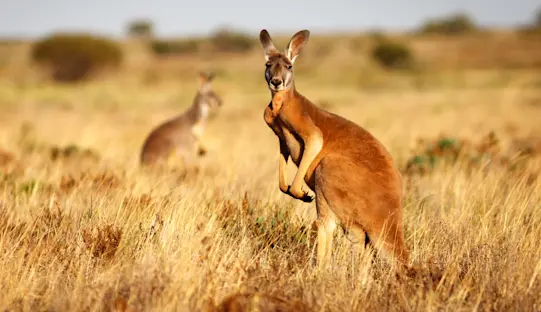Waiting outside the gate of Bandhavgarh National Park in Central India, you feel the crisp morning air leave your lungs, your breath visible with each exhale. Your 4×4 safari vehicle, essential for navigating the rugged back roads of the subcontinent, offers a raised seating area where you sit with a hot water bottle and blanket on your lap, doing their best to keep you warm as the sun begins to peek over the horizon.
There’s a palpable energy among the locals as they sense the park gates are about to open. People rush back to their assigned 4x4s. Your driver gets behind the wheel, a local guide takes the passenger seat, and your naturalist Expedition Leader jumps in, greeting the group and reiterating everyone’s names. You’re about to begin a once-in-a-lifetime experience: tracking tigers in the wild.
This isn’t your first game drive in the park, and though tiger sightings have eluded you so far, you’ve come to appreciate the chase. With that anticipation, a smile forms under your Nat Hab buff.

The gates open and the drive begins, a convoy of 4x4s fanning out across the landscape. Within 15 minutes, each vehicle veers off on its own course, hoping to be the one to spot the elusive striped cat.
Your Expedition Leader turns and tells you and your two fellow travelers that he has a feeling we should scout the territory of a large male. Several females have been active in the area recently, he says. It’s a 45-minute drive with periodic stops along the way.
One of those stops is to watch a herd of spotted deer bathed in early morning golden light. Langur monkeys shake the branches overhead while a startled kingfisher relocates to a quieter tree. Kingfishers are just one of the many avian highlights in India—a birder’s paradise—and you’ve been stunned by the rare and colorful birds you’ve seen over the past few days.

For bear enthusiasts, there’s the added hope of spotting a sloth bear, made famous by The Jungle Book’s Baloo. And while everyone is here to see big cats, focusing too narrowly would mean missing out on the rich array of India’s wildlife.
At a fork in the road, the driver instinctively stops and cuts the engine. You’ve grown used to these silences on your third game drive—opportunities to listen for signs of life in the jungle. The sounds of birdsong and grazing deer suggest predators might be stirring. Everyone listens intently for alarm calls—urgent signals from prey species that a predator is near. You’ve heard them before and fancy yourself able to recognize one if it comes again.

At this stop, all is still. You hear dew dripping from leaf to leaf, falling finally to the jungle floor. You inhale the sweet scent of local foliage mixed with the smoky aroma that seems uniquely Indian. The jungle feels alive. But no alarm call comes. After a quick huddle, the team decides to head left.
The vegetation grows thick. Despite their vibrant colors, you know tigers can disappear in an instant. You scan the underbrush, hoping for a glint of amber eyes in the shadows.
Suddenly, your driver hits the brakes and points to the sandy track. Tiger footprints.
You lean in for a closer look. They’re fresh—your Expedition Leader taught you how to tell. The edges are still sharp, and nearby grasses haven’t yet fallen into the print. A tiger passed through not long ago.
The pursuit begins.
Your 4×4 continues, eyes glued to the trail. The prints might look too narrow to be from a big cat, but your guide explained that tigers step precisely into their own tracks—placing hind paws exactly where their front paws landed—to remain stealthy. The movement is so precise, they rarely glance down.
Your Expedition Leader whistles softly and the vehicle halts. He points to claw marks on a tree about five feet up. He explains that tigers mark their territory in several ways: visually with scratches, and chemically with scent glands in their paws. Your understanding of this wild world grows with every stop.

Farther along, you spot droppings. Your guide identifies them as sloth bear scat—but even more intriguing are the tiger tracks encircling it. The cat clearly investigated the scent. You imagine it pacing, sniffing, pausing at this very spot just minutes ago.
A nearby tree bears a wet patch. Your guide points out residue from a territorial spray—more evidence the tiger is close.
The driver picks up speed. Adrenaline pulses. Rocks and roots barely slow your bouncing ride. The tracks disappear into the underbrush and the brakes are slammed. Another moment of silence. Birds chirp. Langurs rustle fruit from trees.
Then it comes—a loud, unmistakable “owm.”
Everyone freezes. Again: “Owm!”

It’s the alarm call of a spotted deer, a near-certain sign that a big cat—either leopard or tiger—is nearby. The team springs into action, veering toward the direction of the sound.
The morning sun now warms the air, and you peel off your jacket and hat. Your buff catches dust as the 4×4 winds over a hill and around a fallen tree. Then suddenly—everyone feels it.
The vehicle jerks to a stop. Not because of what’s ahead, but because of a powerful, unmistakable smell. Carcass.
Your Expedition Leader turns around and whispers, “That’s the smell of a kill. Not fresh, maybe a day or two old.” He explains that tigers often stay near a carcass until it’s fully consumed. Your eyes scan the dense brush.
Then, a low growl reverberates from just beyond the trees. You stop breathing. Your heart pounds.
A tiger is near.
By Nat Hab Adventure Specialist Joey Sudmeier. Photos © Joey Sudmeier.




































